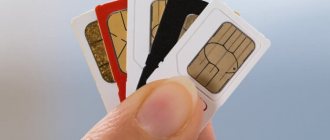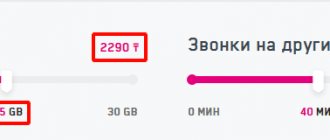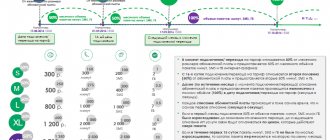The first technology that allowed mobile subscribers to “surf” the Internet at an acceptable speed was, of course, 3G. What is this communication standard and what speeds does it offer? Is 3G Internet available throughout Russia? Which operators use this technology?
- 2 How is 3G different from 4G
- 3 Which operators provide Internet using 3G technology in Russia
3.1 3G coverage map in Russia
- 3.2 Choosing the best operator
Characteristics of 3G technology: standards and speed
3G is the third generation of networks. They are based on the 2G network with the addition of new technologies depending on the communication standard. 3G includes several basic data transmission standards:
- WCDMA. This is one of the first 3G standards. It was with him that the transition to 3G began throughout Europe. The standard covers frequencies in the range 1900 – 2100 MHz and provides speeds of up to 2 Mbit/s.
- UMTS. This is the most popular standard among all 3G technologies. The principle of its operation is the same as that of WCDMA, but it supports a wider frequency range - 1885 - 2025 MHz for transmitting data from the subscriber, and 2110 - 2200 MHz for receiving data. Theoretically, this standard can provide speeds of up to 21 Mbit/s, but practice shows otherwise - only from 384 kbit/s to 7.2 Mbit/s is possible. The maximum speed of 7 Mbps is in principle sufficient for watching streaming video.
- HSDPA (HSPA). This is one of the most developed standards in the 3G technology line. Simple HSPA allows you to “surf” at a speed of 14.4 Mbit/s (incoming), and HSPA+ - at 42.2 Mbit/s. Their outgoing speed is the same - 5.76 Mbit/s. These two standards are also called 3.5G and 3.75G technologies, respectively.
The undeniable advantages of third generation devices
From the description of what 3G Internet is, we can conclude about its main advantages. The device for accessing the Network is independent and mobile. If you need to move frequently while maintaining communication, 3G has no competitors. A 3G modem together with a router can be used to use the Network simultaneously by several computers.
Today, the creation of devices with 3G technology is a technological and knowledge-intensive industry. The development of mobile communication standards makes it possible to use more capabilities in devices that are small in size, while at the same time reducing their cost.
How is 3G different from 4G
4G is already the fourth generation technology. These are more advanced standards. The main difference between 3G and 4G is, of course, speed and minimal risk of connection disruption. Internet speed can reach 100 Mbit/s. Maximum throughput is up to 1 Gbit/s.
4G is suitable for solving more serious problems on the Internet: watching HD videos (that is, high resolution), fast and high-quality downloading of online maps, downloading large files. 3G is best used for viewing email, communicating on social networks and mobile instant messengers (such as WhatsApp, Viber, etc.).
3G is suitable for correspondence in instant messengers and social networks, as well as for regular “surfing” on the Internet
4G technology mainly works only in large Russian cities due to the small number of base stations. But even if you leave the 4G coverage area, your phone or USB modem will automatically switch to 3G (if, of course, the appropriate setting is enabled). The downside of the 4G network is also that it forces the device to consume more energy - it will discharge faster.
First things first
Answering the question of what 3G is is not as simple as it seems at first glance. If you read the meaning of a word in a reference book, little will become clearer; most likely, additional questions will arise. We need to start explaining the term with a story about what the Internet is in general.
The classic interpretation of the word “Internet” suggests that it is a global data repository. Cables carrying packets of information, byte by byte, run beneath the oceans, connecting continents and users. It doesn’t matter where the server will be located with the text answering the question “what is 3G?” (in Africa, America or Europe) - it can be accessed from anywhere in the world. Also, this concept must include all systems and technologies that allow you to store, process and exchange data.
The rapid exchange of information allows thousands of people to work remotely, study, take distance courses, and simply communicate. The Internet has given enormous impetus to the development of the entire information community.
What to do if the 3G speed is low or if the signal is weak: is it possible to somehow speed up the Internet?
If you use the Internet on a smartphone, try moving to a different location, for example, closer to a window. If everything remains unchanged, your area of the city may have poor coverage.
What can be done in this case? Try installing the InternetSpeedMaster program from the official application store of your mobile OS. It optimizes the operation of the device by changing system files. The application works both with and without Root rights. If without “Root”, you need to click on ImproveInternetConnection in the application interface, if with them - on ApplyPatch. After this, the phone is rebooted.
Using the InternetSpeedMaster program, you can speed up your mobile Internet to some extent.
If the program does not help, look for another operator that will provide you with better communication in your area.
If the Internet freezes on a 3G modem, also try to place it directly on the windowsill. It is also advisable to mount it on the window - the higher it is, the better the signal reception. To connect the modem to the computer, use a special USB extension cable.
If you have a 3G Wi-Fi router, buy additional equipment - an antenna with mounts. The antenna itself is installed outside the building - a cable is drawn from it, which connects to the 3G router.
An antenna mounted outside the building will amplify the signal from the operator's base station
Frequency ranges and their use in Russia
Mobile communications began to gain mass popularity in Russia in the late 90s with the advent of 2G technology. 3G appeared in 2007 and led to an increase in mobile Internet traffic as data transfer speeds increased significantly.
In 2015-2016, the 4G standard appeared in Russian regions. At the time of writing, 5G in Russia is at the testing stage.
Distribution of communication standards by frequency range in Russia
Distribution of cellular operators by frequencies and regions
| 450 MHz (LTE-450) | ||
| Uplink (MHz) | Downlink (MHz) | |
| Skylink (Tele2) | 453–457,4 | 463–467,4 |
| 800 MHz (LTE-800) This frequency has been used since 2012 for mobile broadband access: transmission of 4G LTE Internet and Internet things, mainly outside the city. | ||
| Uplink (MHz) | Downlink (MHz) | |
| Megaphone | 847–854,5 | 806–813,5 |
| MTS | 839,5–847 | 798,5–806 |
| Beeline | 854,5–862 | 813,5–821 |
| Tele 2 | 832–839,5 | 791–798,5 |
| To strengthen the cellular signal and the Internet at 800 MHz, select the appropriate section: Repeaters 800 MHz 800 MHz repeater kits 4G routers for operation at 800 MHz LTE 800 antennas | ||
| 900 MHz (GSM-900, UMTS-900) This frequency is used for voice communications, mobile 3G (UMTS-900) Internet | ||
| In Moscow | ||
| Uplink (MHz) | Downlink (MHz) | |
| Megaphone | 910–913 | 955–958 |
| MTS | 890–894,8 904,8–910 913–915 | 935–939,8 949,8–955 958–960 |
| Beeline | 894,8–904,8 | 939,8–949,8 |
| Tele 2 | — | — |
| In St. Petersburg | ||
| Uplink (MHz) | Downlink (MHz) | |
| Megaphone | 890–894,8 907,6–915 | 935–939,8 952,6–960 |
| MTS | 894,8–903 | 939,8–948 |
| Beeline | 903–907,6 | 948–952,6 |
| Tele 2 | — | — |
| To strengthen the cellular signal and the Internet at 900 MHz, select the appropriate section: Repeaters 900 MHz 900 MHz repeater kits 3G routers for operation at 900 MHz GSM 900 MHz antennas | ||
| 1800 MHz (GSM-1800, LTE-1800) This frequency is actively used for the Internet, Internet things, voice data transmission, etc. | ||
| In Moscow | ||
| Uplink (MHz) | Downlink (MHz) | |
| Megaphone | 1730,2–1760,2 | 1825,2–1855,2 |
| MTS | 1760,2–1785 | 1855,2–1880 |
| Beeline | 1710–1730,2 | 1805–1825,2 |
| Tele 2 | — | — |
| In St. Petersburg | ||
| Uplink (MHz) | Downlink (MHz) | |
| Megaphone | 1744,2–1755 1767,2–1776,8 | 1839,2–1850 1862,2–1871,8 |
| MTS | 1737,8–1744,2 1755–1767,2 | 1832,8–1839,2 1850–1862,2 |
| Beeline | 1725–1737,8 1776,8–1779 | 1820–1832,8 1871,8–1874 |
| Tele 2 | 1710–1725 1779–1785 | 1805–1820 1874–1880 |
| To strengthen the cellular signal and the Internet at a frequency of 1800 MHz, select the appropriate section: Repeaters 1800 MHz 1800 MHz repeater kits 4G routers for operation at 1800 MHz GSM 1800 MHz antennas | ||
| 2100 MHz (UMTS-2100) These frequencies are used for mobile 3G Internet and voice communications. | ||
| Uplink (MHz) | Downlink (MHz) | |
| Megaphone | 1935–1950 | 2125–2140 |
| MTS | 1950–1965 | 2140–2155 |
| Beeline | 1965–1980 | 2155–2170 |
| Tele 2 | 1920–1935 | 2110–2125 |
| To strengthen the cellular signal and the Internet at a frequency of 2100 MHz, select the appropriate section: Repeaters 2100 MHz 2100 MHz repeater kits 3G routers for operation at 2100 MHz Antennas 3G 2100 MHz | ||
| 2600 MHz (LTE-2600) This frequency is used for Internet of Things and 4G (LTE) Internet | ||
| Uplink (MHz) | Downlink (MHz) | |
| Megaphone | 2500–2540 | 2620–266 |
| MTS | 2540–2550 | 2660–2670 |
| Beeline | 2550–2560 | 2670–2680 |
| Tele 2 | 2560–2570 | 2680–2690 |
| To strengthen the cellular signal and the Internet at a frequency of 2600 MHz, select the appropriate section: Repeaters 2600 MHz 2600 MHz repeater kits 4G routers for operation at 2600 MHz LTE 2600 MHz antennas | ||
Despite the resolution of the SCRF and licenses issued by government bodies of the Russian Federation, the sharing of frequencies by several operators using RAN-Sharing technology has been permitted and practiced for several years.
RAN-Sharing allows not only the installation of joint operator towers, but also the use of common frequencies - this blurs the division of bands between cellular operators and gives them the opportunity to save on building and optimizing networks.
DECT, Wi-Fi, TV and walkie-talkies
Do not forget that in the frequency air there is not only cellular communication, but also DECT, Wi-Fi, TV and radio broadcasting. Due to the fact that different frequency ranges are used, the standards do not interfere with each other in any way.
| TV (DVB-T2) | 470–790 MHz |
| Radio stations | 26.975–27.855 MHz 433.075–434.775 MHz 446.000–446.100 MHz |
| DECT | 1880–1900 MHz |
| WiFi | 2400–2483.5 MHz 5150–5350 MHz 5650–5850 MHz |
If we compare what frequencies the operator occupies and what standards are present in these frequencies, we get:
- 800 MHz – all operators have 4G
- 900 MHz – 2G, 3G and 4G can be present on all operators except Tele2, since this operator is not present in this frequency range
- 1800 MHz – 2G and 4G, perhaps for all operators, but in Moscow and the Moscow region there is no Tele2 on this frequency.
- 2100 MHz – 3G is present and 4G may be present for all operators.
- 2600 MHz – frequencies for 4G for all cellular operators.
In order to accurately understand which frequencies need to be amplified, it is necessary to measure the signal, which is performed using special equipment - a spectrum analyzer.
Only professional measurement allows you to correctly obtain all the signal data and correctly select the necessary equipment, especially when it comes to objects with an area of more than 200 m2.
Which phones support 3G
Most phones that were released by manufacturers after 2007 support the 3G communication standard. Their approximate cost is from 5 thousand rubles. Here is a list of some models and series:
- Nokia: second, third, fifth, sixth, seventh, eighth series; as well as N, E, C, X series.
- Samsung Galaxy (all models), Wave, Beam, Shark, Strive, Rugby II, B7722, Vibrant, Gravity, Focus, Nexus.
- Sony Ericsson Xperia, Aspen, Vivaz, Zylo, Cedar, Yari, Jalou; as well as series C, W, T, G, K.
- LG Optimus, Phoenix, Cookie, Lollipop, Viewty Smile, Arena, Chocolate, Crystal, Secret, as well as KU and U series.
- Motorola Atrix, Droid Pro, Milestone, Defy, FlipOut, Quench, Backflip, MT710.
- iPhone 3G, 3Gs, 4, 4S, etc.
- Almost all HTC, Acer and BlackBerry smartphones since 2006.
If you don’t find your model in the list and doubt that it supports 3G, you can always open the documentation for the phone - everything should be indicated there. If you do not have any documents for the device, find the operating instructions for the mobile device on the Internet - on the manufacturer’s official website.











